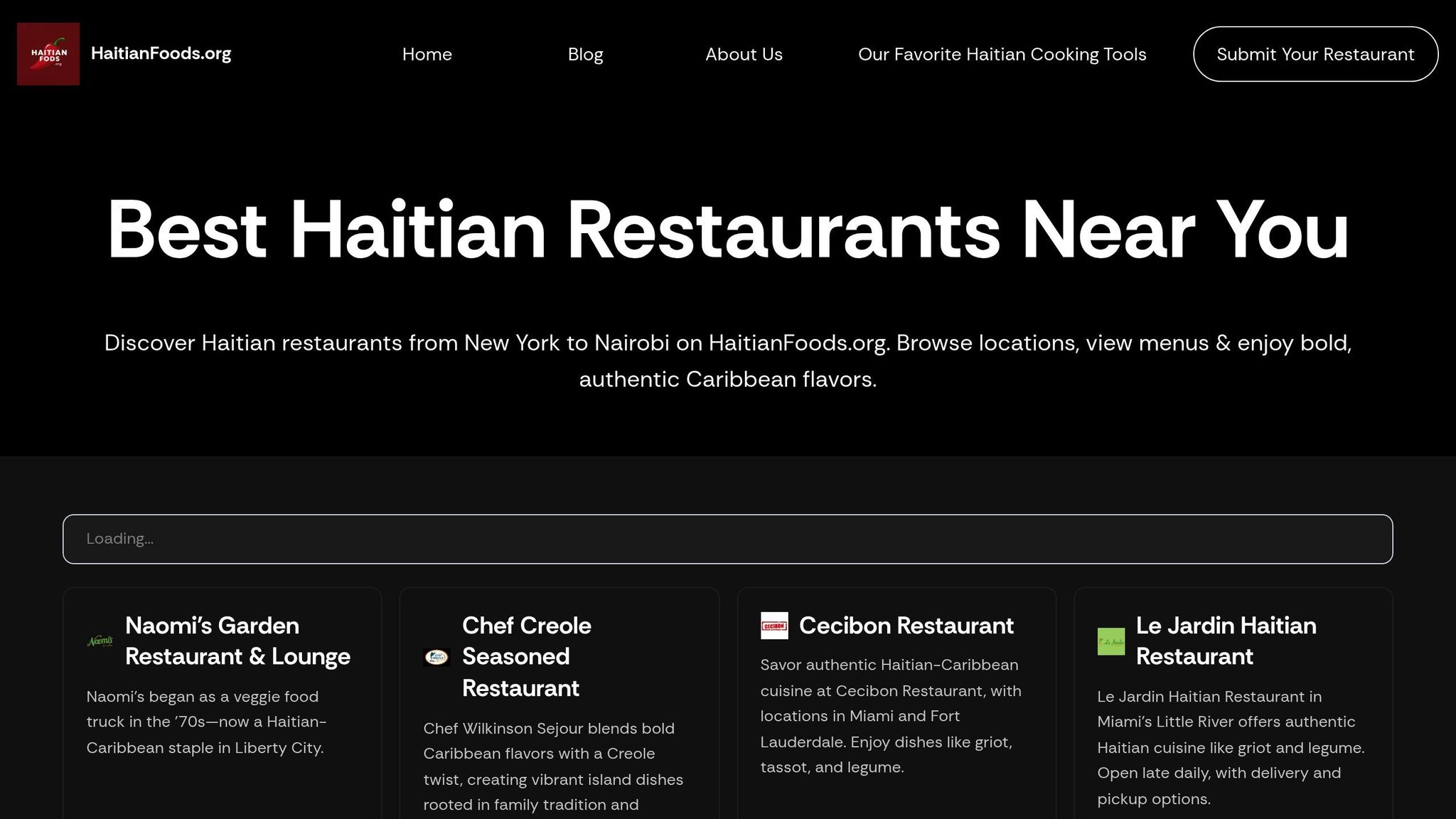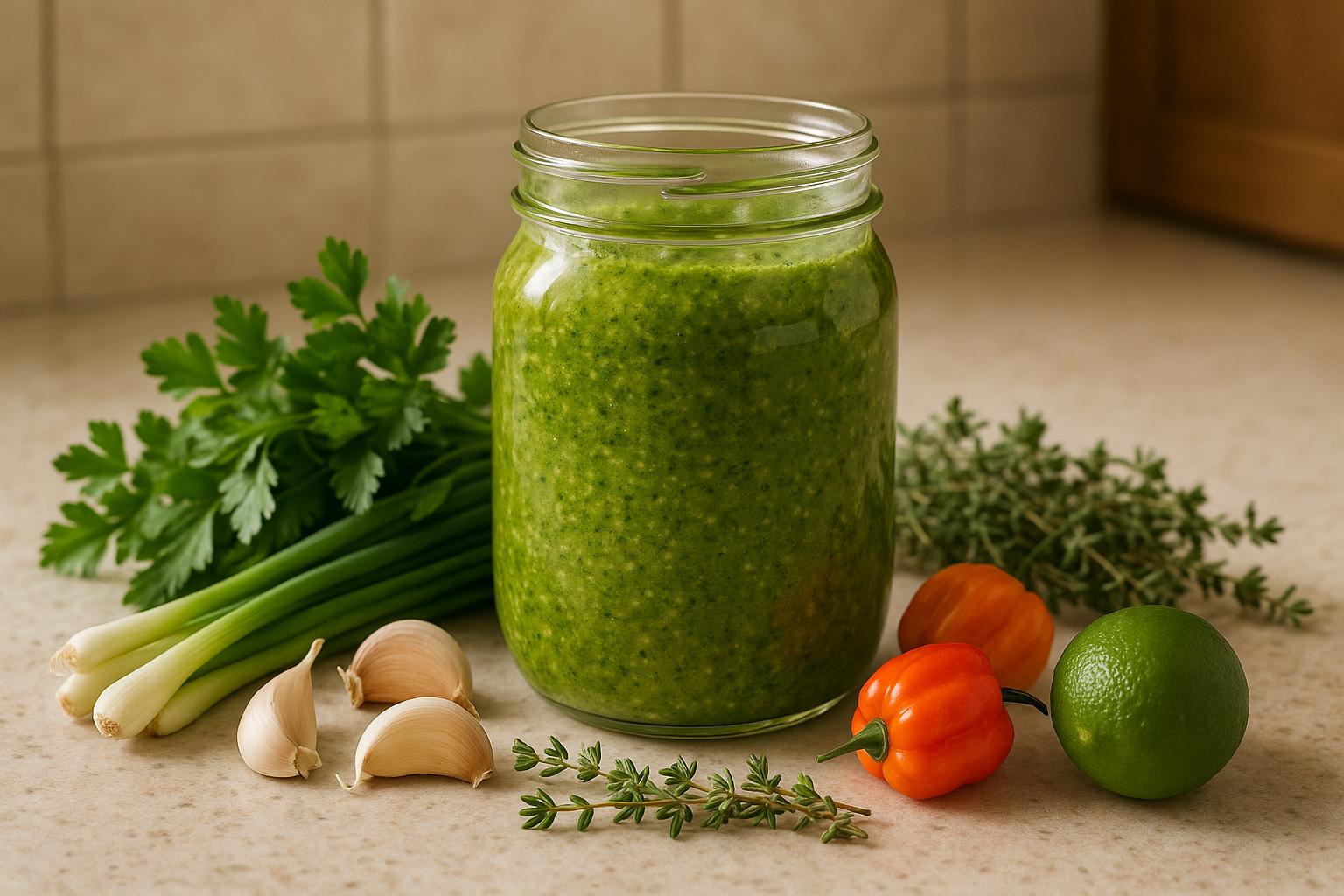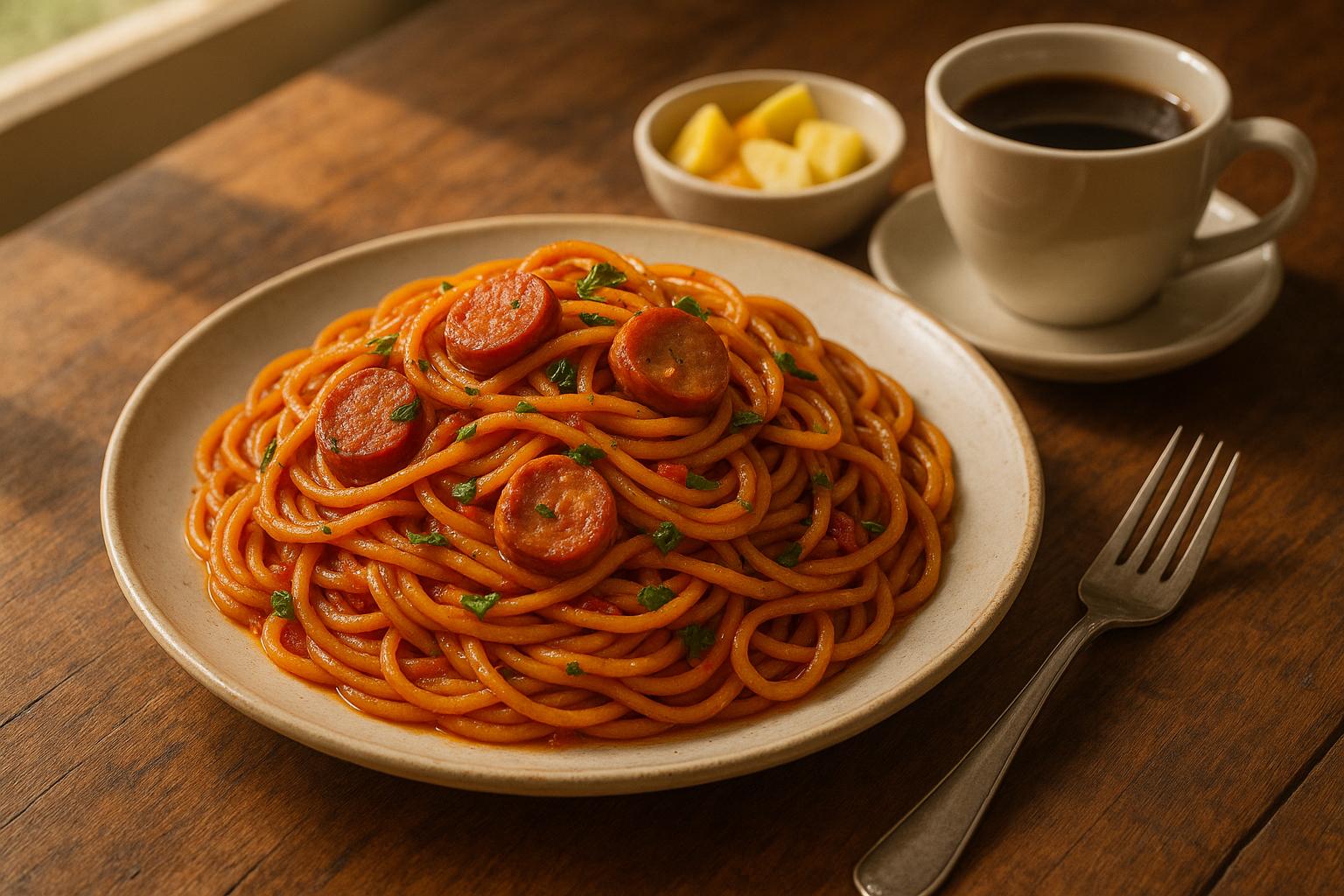Haitian street food has evolved over centuries, shaped by history, migration, and economic challenges. From the Taíno's early cooking methods to African, French, and Spanish influences, this cuisine reflects Haiti’s complex past. Today, street vendors play a key role in feeding urban populations, offering affordable meals in a country where 40% of households face undernourishment. Modern vendors balance traditional recipes with global flavors, despite rising ingredient costs and supply chain disruptions caused by inflation and gang violence. This evolution highlights how street food remains a practical solution for daily life while preserving Haiti's culinary heritage.
How Haitian Cuisine Became a Powerhouse in Miami's Culinary Scene - MOFAD

Colonial and Early Influences on Haitian Street Food
The story of Haitian street food is deeply rooted in history, shaped by the blending of cultures over centuries. When Christopher Columbus arrived at Môle Saint-Nicolas on December 5, 1492, claiming the island he called La Isla Española (later Hispaniola) for Spain [4], it marked the beginning of a culinary evolution that would define Haiti's food traditions for generations. This fusion of influences created the foundation for the rich and diverse street food culture seen today.
Indigenous Taíno and African Contributions
The Taíno, the indigenous people of Hispaniola, were the first to shape what would eventually become the essence of Haitian street food [4][6]. Their traditions, like slow-cooking meat over an open flame - a practice known as "barbecue", derived from the Taíno word barabicu - remain central to Haitian cooking and street food.
Staples introduced by the Taíno, such as yams, cassava, and corn, are still widely used by street vendors across Haiti [5][6]. These ingredients laid the groundwork for a cuisine that has endured through centuries of change.
However, the Spanish colonization brought devastating consequences for the Taíno population. The establishment of sugar plantations and harsh labor conditions, combined with disease, led to the near extinction of the Taíno by 1520 [8]. To replace the dwindling labor force, the Spanish began importing enslaved Africans, whose culinary traditions profoundly influenced Haitian food.
"African culinary traditions heavily influence Haitian cuisine, with staples like rice, beans, plantains, and various spices being central to many dishes. Techniques such as stewing, frying, and marinating are also reminiscent of African cooking methods." - Haitian Food Network [6]
Africans brought with them ingredients like okra, ackee, taro, and a vibrant array of spices that continue to define Haitian street food [4][7]. These contributions remain the backbone of many dishes, reflecting the heritage of the majority of Haitians, who are descendants of these enslaved Africans [6].
Impact of French and Spanish Colonization
Colonial powers left a lasting mark on Haitian food culture. Spanish colonization introduced sugar plantations, which not only shaped agriculture but also influenced the ingredients available to the local population [8]. Later, when the French took control of Hispaniola in the early 1700s, they further transformed the island's culinary identity [8].
The French cultivated crops like sugarcane, coffee, cotton, and cocoa using enslaved labor [8]. While these crops were primarily grown for export, they gradually became part of local food traditions. Coffee, for instance, became a staple sold by street vendors, and sugar inspired the creation of sweet treats now commonly found in Haitian markets and on street corners.
French culinary influence is still evident in Haitian street food today. French cheeses, breads, and desserts are staples in local markets [4]. The fusion of French techniques with Taíno and African cooking methods created a unique culinary identity, blending flavors and practices that continue to thrive in Haiti's street food scene.
Emergence of Informal Food Trade
During colonial times, Haiti's informal food economy began to take shape. While plantations dominated the formal economy, enslaved people and free people of color developed their own food networks to sustain themselves. These networks combined Taíno preservation methods, African spices and cooking techniques, and European ingredients, creating practical and flavorful solutions for feeding communities outside the plantation system.
Traveling food traders began selling prepared dishes and ingredients between settlements, laying the groundwork for the vibrant street food culture that would flourish in later years. Following the Haitian Revolution in 1804, Haitian migrants carried these food traditions abroad, influencing cuisines such as Louisiana Creole [4].
The colonial period set the stage for Haiti's street food culture by fostering a diverse, resourceful population and an informal food economy. These elements combined to create a cuisine that is both practical and rich in flavor - qualities that continue to define Haitian street food today.
Post-Independence Changes in Street Food
When Haiti achieved independence from France in 1804, it didn’t just mark a political turning point - it also transformed the nation’s food culture. Freed from colonial restrictions, Haitians reclaimed their culinary traditions, creating a vibrant food scene that reflected both heritage and newfound freedom. This shift laid the groundwork for the dynamic street food culture we see in Haiti today, blending deep-rooted traditions with creative evolution.
Local Staples and Food Identity
Post-independence, Haitian cooks turned to local ingredients to craft a distinct culinary identity. Staples like rice, corn, millet, yams, and beans became the backbone of the Haitian diet [3]. Among these, Riz et Pois (rice and beans) emerged as a national symbol, while cornmeal paired with beans became another everyday favorite [11]. Street vendors transformed these staples into portable, flavorful dishes such as fritay (fried snacks), fried plantains, griot (seasoned fried pork), and barbecued chicken - foods that have come to define Haiti’s street food culture [3].
Tropical fruits like avocados, mangoes, pineapples, coconuts, and guava complemented the savory dishes, offering a natural balance of flavors [3]. One dish, soup joumou (pumpkin soup), stands out as a culinary emblem. Once a meal forced upon enslaved people, it now symbolizes freedom and resilience, served every January 1 to celebrate Haitian independence. In 2021, it was honored as Intangible Cultural Heritage by UNESCO [9][11][12].
This strong foundation of local traditions paved the way for the influences that migration would later bring.
Refugee and Migration Influences
Migration, both within Haiti and abroad, introduced fresh perspectives to the country’s street food while staying true to its roots. In the years following independence, Haitians moved to escape challenges, bringing their culinary traditions with them. As they settled in new places, these migrants infused regional and global influences into Haitian street food, enriching its diversity while preserving its core identity.
Street vendors played a key role in this evolution. They acted as cultural storytellers, blending new ingredients and techniques into their recipes without losing the essence of Haitian cooking. Time-honored practices like slow braising and citrus-based marinating remained central to achieving the rich, complex flavors that define Haitian cuisine [12]. Migration also sparked creativity, as vendors developed practical solutions - such as portable cooking setups and methods to preserve food - to adapt to changing circumstances. These innovations ensured that the street food scene continued to evolve while remaining deeply connected to its traditional roots [12].
Modern Changes in Haitian Street Food
Haiti's street food scene, deeply rooted in its culinary traditions, has undergone noticeable changes in recent years. These shifts are driven by economic challenges, urbanization, and the blending of local and global influences, reshaping how Haitians experience their everyday meals.
Urbanization and Street Food Hubs
Port-au-Prince stands at the center of Haiti's street food transformation. As rural populations migrated to the capital in search of better opportunities, the demand for quick, affordable meals surged. Street food vendors rose to the occasion, providing a practical solution for urban dwellers needing inexpensive and accessible meals [1][2].
Studies highlight street food's vital role in urban diets, offering affordable alternatives as families transitioned from agricultural livelihoods to wage-based urban work. With restaurant markups often exceeding 50%, street vendors became indispensable to the daily lives of many Haitians [1][2].
Take Champs-de-Mars, for instance, where the impact of urbanization is evident. After escaping gang violence in 2023, vendor Dieufort Dassilien invested 4,000 Gourdes (about $30 USD) in a makeshift setup - a large boiler and a wheelbarrow. By mid-2024, his mobile operation was reliably serving affordable rice and peas to locals in the area [14].
"We serve teachers, students, porters and shoe polishers. I feel useful to my community, while allowing them to ease their hunger at a price that works for everyone." – Jocelyne Jean Baptiste, Street Food Vendor [13]
This growing demand and urban migration have also encouraged vendors to experiment and incorporate global culinary trends into their offerings.
Global Influences and New Recipes
Haitian street food is evolving as vendors blend traditional recipes with international flavors. Middle Eastern spices, for example, are finding their way into fusion dishes that retain a Haitian essence while offering something new. These subtle tweaks in spice blends and cooking techniques breathe fresh life into classic street food, keeping the cuisine both rooted in tradition and open to change.
But while creativity thrives, vendors must also grapple with economic challenges that affect ingredient availability and pricing.
Economic Changes and Ingredient Availability
Economic hardships have significantly impacted the availability and affordability of ingredients. Haiti, the poorest nation in Latin America, faces inflation and currency depreciation, which continually drive up food prices [15]. Vendors are often forced to make tough choices to maintain affordable prices for their customers.
Local agriculture has been hit hard. Environmental challenges and gang violence have caused dramatic declines in crop production - maize is down by 39%, rice by 34%, and sorghum by 22% compared to five-year averages [15]. This has made vendors increasingly reliant on imported goods, which come with higher costs and unpredictable supply chains.
The role of gangs in controlling transportation routes and farming areas further complicates the situation. Criminal groups impose unofficial taxes and disrupt supply chains, adding to the financial strain on vendors [15].
"Gangs control key transportation routes and farming areas, causing significant impact. The increase in crime causes challenges on product supply routes as well." – Haitian Development Network [15]
Despite these obstacles, vendors display remarkable resilience. For instance, a 110-pound bag of imported American rice costs about 4,000 Gourdes ($30 USD), yet vendors like Luckson Duclair manage to sell full meals for just 100 Gourdes ($0.76 USD). Duclair travels five miles daily from Pétion-Ville to Champs-de-Mars, demonstrating the dedication it takes to sustain a street food business [14].
Economic struggles have also shifted the demographic makeup of street vendors. Traditionally dominated by women, the trade is now attracting young men who see it as a safer alternative to gang involvement.
"We prefer being on the streets daily rather than joining a gang. At least this way, we can buy a loaf of bread when needed. Though we can't go to certain areas, that won't stop us from selling." – Dieufort Dassilien, Street Food Vendor [14]
These vendors are more than just food sellers - they are vital contributors to their communities. In areas where 40% of households are undernourished, street food serves as an affordable bridge between costly restaurant meals, which average 250 Gourdes ($4 USD), and the daily nutritional needs of struggling families [13].
sbb-itb-80c33ff
Old vs. New Street Foods: A Comparison
Haitian street food has undergone a fascinating transformation, blending its rich heritage with modern touches. From humble wooden carts to sleek mobile kitchens, this evolution mirrors the country's changing economic and social landscape.
In the past, street food in Haiti was born out of necessity and local resources. Vendors, known as "machant", operated with simple wooden carts and minimal tools [18]. As Mirlene Desir from SavoryThoughts.com notes:
"The country is poor. Most people cannot afford to buy vegetables on a daily basis. Therefore, they resort to rice and beans, corn, grains, and plantains" [16].
She also highlights the cultural significance of food preparation:
"The people of Haiti take great pride in how food is prepared and served. No matter the economic class, food is always served with such grace and appreciation" [16].
Historically, Haiti was a major producer of chocolate, sugar, and coffee, though these were often expensive for locals to buy [16]. Today, street food vendors have expanded their offerings, incorporating international ingredients and fusion dishes, while still relying on affordable staples like bouillon cubes [4][16].
Modern street food stands out with its upgraded equipment and presentation. Vendors now use mobile kitchens equipped with cooling systems, solar panels, and enhanced hygiene measures [17]. The influence of global cuisine is evident in dishes like Chef Vanesa Cantave's Haitian Roasted Pork Bao Buns, which reimagine the classic griyo by pairing citrus-and-habanero-marinated pork with soft bao buns and pikliz [10]. Below is a comparison highlighting the key differences between traditional and modern street food.
Comparison Table of Key Characteristics
| Aspect | Traditional Street Food | Modern Street Food |
|---|---|---|
| Equipment | Basic wooden carts and simple tools | Mobile kitchens with cooling systems, solar panels, and advanced cooking tools [17] |
| Ingredients | Staples like rice, beans, corn, and plantains [16] | A mix of local and international ingredients, including fusion dishes [17][12] |
| Cooking Methods | Slow braising, stewing, and citrus marination [12] | Traditional techniques adapted with modern appliances like slow cookers [12] |
| Menu Variety | Limited to local dishes, primarily fritay (fried foods) [4] | Upscale options, international cuisine, fusion meals, and plant-based dishes [17][12] |
| Presentation | Functional and simple serving methods | Enhanced aesthetics designed to attract both locals and tourists [17] |
| Customer Base | Mostly local community members | A mix of locals and tourists [17] |
Traditional cooking techniques like slow braising and citrus marination remain essential for capturing authentic Haitian flavors. However, modern kitchens have embraced appliances like slow cookers to replicate these rich flavors with greater efficiency [12].
This evolution reflects broader societal changes, including the shift from an agricultural economy to urban-based wage labor, which has reshaped both dietary habits and the role of street food in Haitian culture [1].
Finding Haitian Street Food Today
Haitian street food has come a long way, blending tradition with modern influences to reach communities around the globe. Today, you can enjoy authentic Haitian flavors whether you're craving classic dishes like fritay or exploring creative fusion options. The key to discovering these culinary treasures lies in knowing where to look and connecting with the Haitian community. In the United States, cities like Boston, New York, and Miami have become hubs for Haitian cuisine, thanks to their vibrant Haitian populations. Food trucks have also become a fantastic way to sample these flavors. Take, for example, King Queen Haitian Cuisine, a food truck located about 45 minutes from Greensboro, North Carolina, serving up favorites like griot and pikliz [20]. These modern outlets make it easier than ever to experience the richness of Haitian street food.
Using HaitianFoods.org as a Resource

If you're looking for a reliable guide to Haitian street food and restaurants, HaitianFoods.org is a fantastic resource. This platform offers a directory of Haitian eateries and a "Taste of Haiti Blog" filled with recipes and cultural insights. Restaurant owners can keep their listings up to date on the site, ensuring the information stays fresh. For those who need a more personal touch, HaitianFoods.org also provides direct assistance and recommendations to help you find the best spots.
Supporting Haitian-Owned Businesses
Exploring Haitian street food is about more than just the food - it's about building connections. Supporting Haitian-owned businesses not only enriches your dining experience but also strengthens community ties. Attending local Haitian events, joining cultural organizations, or networking through professional platforms can lead you to hidden culinary gems. Engaging with vendors, learning their stories, and showing consistent support helps keep Haiti's vibrant street food traditions alive [19]. By taking these steps, you're not just enjoying great food - you’re helping preserve a rich cultural legacy.
Conclusion: The Legacy of Haitian Street Food
Haitian street food is a powerful reflection of a culture that has endured and adapted through centuries of change. Drawing from African, French, Spanish, and indigenous Taíno influences, this cuisine tells a story of resilience and evolution, encapsulating Haiti's rich history [4].
When Haitian immigrants began arriving in the United States during the 1950s and 1960s, escaping political and economic turmoil, they brought with them a culinary heritage that found new life in cities like Miami, New York, and Boston. These traditions adapted to their surroundings while staying true to their roots, ensuring that the essence of Haitian street food thrived in unfamiliar environments [21].
Today, Haitian street food continues to evolve, blending tradition with modern creativity. Chefs like Gregory Gourdet of Kann in Portland and Nadege Fleurimond in New York are reimagining classic recipes while honoring their origins [21]. Meanwhile, entrepreneurs such as Tessa Jean-Baptiste of Miami's Tap Tap Now are striking a balance between preserving traditional flavors and catering to modern tastes with locally sourced ingredients [21]. This fusion of past and present keeps the spirit of Haitian cuisine alive and relevant.
In Haiti itself, street vendors - primarily women - are vital to the nation’s culinary identity. In a country where over 60% of the population lives below the poverty line and unemployment affects 40%, these vendors, known as machant, represent the resilience and entrepreneurial spirit that have long defined Haitian culture [22].
The recognition of Soup Joumou as an Intangible Cultural Heritage of Humanity by UNESCO in 2021 highlights the historical and cultural significance of Haitian cuisine [12]. This honor celebrates not just a dish but a community's ability to preserve its identity through food, even in the face of adversity.
As Haitian street food continues to embrace plant-based options, fusion influences, and modern culinary techniques, it remains a bridge between tradition and innovation. Whether served from food trucks in North Carolina or restaurants in Boston, each dish carries with it a legacy of perseverance and cultural pride. The future of Haitian street food lies in its ability to honor its roots while embracing new possibilities, ensuring its story continues to inspire and connect communities worldwide.
FAQs
How have global influences and migration shaped Haitian street food while keeping its traditional flavors alive?
Global influences and migration have significantly shaped Haitian street food, weaving new ingredients and cooking techniques into its already rich tapestry of flavors. Haitian cuisine, deeply rooted in African, French, and indigenous Taíno traditions, has embraced these outside influences to create dishes that feel both familiar and refreshingly varied.
As Haitians have migrated and established communities around the world, their street food has adapted in fascinating ways. Local ingredients and global culinary trends have been incorporated into traditional recipes, giving them a modern twist while still honoring their origins. Yet, no matter how much it evolves, Haitian street food remains a celebration of its history, reflecting the resilience and pride of its people.
What challenges do Haitian street food vendors face today, and how are they adapting to economic and supply chain issues?
Challenges Facing Haitian Street Food Vendors
Haitian street food vendors are navigating a tough landscape marked by political instability, gang violence, and disruptions in supply chains. These factors have led to food shortages and soaring prices, making it increasingly difficult for vendors to sustain their businesses.
In response, many vendors are turning to local and informal markets to source ingredients, ensuring they can keep their operations afloat despite the challenges. Others have shifted their focus to selling prepared meals directly on the streets. This approach not only sidesteps unreliable supply chains but also allows vendors to serve their communities more effectively. These strategies highlight the resourcefulness and determination of Haitian street food vendors as they adapt to these trying times.
How does Haitian street food showcase the country’s history and cultural heritage, especially its colonial past and independence?
Haitian street food is a lively celebration of the country’s rich history and heritage, blending flavors and techniques from Africa, France, the Taíno people, and Spain. Dishes like griyo (fried pork) and diri ak pwa wouj (red beans and rice) have deep African roots, brought to Haiti during the colonial era. Over time, these recipes evolved into symbols of resilience and cultural pride, especially after the nation gained its independence.
French influence shines through in the bold spices and refined cooking methods, while indigenous Taíno staples like cassava and plantains connect modern Haitian cuisine to its pre-colonial origins. Together, these elements create a flavorful narrative of Haiti’s journey through colonization, independence, and beyond. Haitian street food isn’t just a meal - it’s a flavorful tribute to the country’s diverse and storied past.


